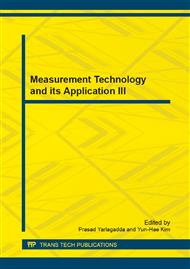[1]
OKAMOTO AKIRA, WASA YASUHIRO, SUZUKI NORIO. Automatic Ultrasonic Inspection System for Steel Castings and Forgings. Research and Development Kobe Steel Engineering Reports, 10(6), pp.16-21, (2007).
Google Scholar
[2]
Balasubramaniam K, Sean C Whitney. Ultrasonic through transmission characterization of thick fibre reinforced composites J. NDT & E International , 29(4), pp.225-236. (1996).
DOI: 10.1016/s0963-8695(96)00014-x
Google Scholar
[3]
ClARK R. Rail flaw deteetion: overview and needs For future developments. NDT & E International, , 37, pp.111-1182004.
DOI: 10.1016/j.ndteint.2003.06.002
Google Scholar
[4]
OPPENHEIM I J, JAIN A, GREVE D W. Ultrasonic Transducers for the Testing of Solids. Ultrasonics, 50(3), pp.15-31, (2008).
Google Scholar
[5]
R Clark, S Singh and C Haist, Ultrasonic characterization of defects in rails, Insight, Vol 44, pp.341-347, (2002).
Google Scholar
[6]
S Kenderian, D Cerniglia, B B Djordjevic, G Garcia, R Morgan, J Sun and M Snell, Proof of concept using a laser-air of wayside railroad wheel inspection hybrid ultrasonic technique, Insight, Vol 45, pp.621-627, (2003).
DOI: 10.1784/insi.45.9.621.52934
Google Scholar
[7]
RAINER P, ERHARD A, MONTAG H J, et al. NDT techniques for railroad wheel and gauge corner inspection[j]. NDT & International, 2004, 37: 89一94.
DOI: 10.1016/j.ndteint.2003.06.001
Google Scholar
[8]
Ke W, Castaings M, Bacon C. 3D finite element simulations of an air-coupled ultrasonic NDT system. NDT & E International, 42(6), pp.524-533, (2009).
DOI: 10.1016/j.ndteint.2009.03.002
Google Scholar
[9]
KENDERIAN S, DJORDJEVIC B B, ROBERT E, et al. Laser based and air coupled ultrasound as noncontact and remote techniques for testing of railroad tracks. Materials Evaluation, 60, pp.65-70, (2002).
Google Scholar
[10]
Detecting Small Flaws at Far Surface of Steel Plate. 7Th Annual International Conference on Electrical Engineering/Electronics, Computer, Telecommunications and Information Technology. 9(26), pp.168-172, (2010).
Google Scholar
[11]
EDWARDS R S, HOLME S C, FAN Y, et al. Ultrasonic detection of surface breaking rail head defects[j]. Insight-non-Destructive testing and Condition Monitoring, 50(7), pp.1-5, (2008).
DOI: 10.1784/insi.2008.50.7.369
Google Scholar
[12]
Drai R, Khelil M, Benchaala A. Time frequency and wavelet transform applied to selected problems in ultrasonics NDE [J]. NDT & E International, 35(8), pp.567-572, (2002).
DOI: 10.1016/s0963-8695(02)00041-5
Google Scholar
[13]
GRANVILLE R K, TAYLOR J L. Improvement in Signal-to-Noise Ratio During the Ultrasonic Testing of Titanium Alloys. British Journal of Non-Destructive Testing, 28(4), pp.228-231, (2008).
Google Scholar
[14]
ROY O, MAHAUT S, CASULA O. Control of the Ultrasonic Beam Transmitted Through an Irregular Profile Using a Smart Flexible Transducer Modeling and Application. Ultrasonics, 40(6), pp.243-246, (2007).
DOI: 10.1016/s0041-624x(02)00145-2
Google Scholar
[15]
Baek E, Yim H. Numerical modeling and simulation for ultrasonic inspection of anisotropic austenitic welds using the mass-spring lattice model [J]. NDT & E International, 44(7), pp.571-5822011.
DOI: 10.1016/j.ndteint.2011.05.011
Google Scholar
[16]
BIRT EA, SMITH RA, SCRUBY CB. Improved Ultrasonic Spectroscopy Procedure for Rough Measurement of Hidden Corroded Surfaces. Insight, 46(3), pp.151-156 (2008).
DOI: 10.1784/insi.46.3.151.55519
Google Scholar


